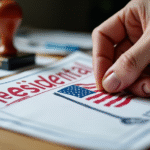Introduction
In a joint appearance with U.S. President Donald Trump in Washington, Israeli Prime Minister Benjamin Netanyahu cautiously endorsed the plan. After days of speculation, the White House released Trump’s 20-point proposal aimed at ending nearly two years of conflict in Gaza, freeing hostages held by Hamas, and shaping the future of the Palestinian enclave.
The 20 Points of Trump’s Plan
- Gaza will be a terrorism-free and de-radicalized zone, posing no threat to its neighbors.
- Gaza will be rebuilt for the benefit of its population, which has already suffered more than enough.
- If both parties agree, the war will end immediately. Israeli forces will withdraw to the agreed line to prepare for hostage release. During this time, all military operations will cease, and battle lines will remain frozen until conditions for complete and gradual withdrawal are met.
- Within 72 hours of Israel’s public acceptance of this agreement, all hostages, both living and deceased, will be returned.
- Upon the return of all hostages, Israel will release 250 life-sentenced prisoners and 1,700 Gazans detained after October 7, 2023, including all women and children held in that context. For each Israeli hostage whose remains are returned, Israel will release the remains of 15 deceased Gazans.
- Once all hostages are returned, Hamas members committing to peaceful coexistence and disarmament will receive amnesty. Hamas members wishing to leave Gaza will be provided with a safe passage to receiving countries.
- Immediately after the agreement’s acceptance, all aid will be sent to Gaza. The amount will adhere to the 2025 Humanitarian Aid Agreement, including infrastructure rehabilitation, hospital improvements, and the deployment of debris removal teams and road-opening equipment.
- Aid entry and distribution in Gaza will occur without interference through the United Nations, Red Crescent, and other international non-partisan organizations.
- Gaza will be governed by a Palestinian technocratic committee, responsible for daily public service and municipal management. This committee will consist of qualified Palestinians and international experts under the supervision of a new international transition body, the “Peace Board,” chaired by President Trump. Members and heads of state will be announced soon, including former British Prime Minister Tony Blair. This body will establish the framework and manage funding for Gaza’s reurbanization until the Palestinian Authority completes its reform program.
- Trump will develop an economic development plan to rebuild and revitalize Gaza by convening a panel of experts who have contributed to the prosperity of modern Oriente Medio cities.
- A special economic zone will be established with preferential tariffs and access rates negotiated with participating countries.
- No one will be forced to leave Gaza, and those wishing to depart will be free to do so and return.
- Hamas and other factions agree not to govern Gaza directly or indirectly, nor in any form. All military, terrorist, and offensive infrastructure, including tunnels and weapon production facilities, will be destroyed and not rebuilt. A de-militarization process of Gaza will be supervised by independent observers.
- Regional partners will ensure Hamas and factions comply with their obligations, and New Gaza does not threaten neighboring countries or populations.
- The U.S. will collaborate with Arab and international partners to develop a temporary International Stabilization Force, which will deploy immediately in Gaza. This force will train and support accredited Palestinian police forces in Gaza, maintain consultations with Jordan and Egypt, and collaborate with Israel and Egypt to secure border areas.
- Israel will not occupy or annex Gaza. As the International Stabilization Force establishes control and stability, Israeli Defense Forces (IDF) will withdraw according to agreed-upon standards, milestones, and timelines linked to de-militarization between both parties, guarantors, and the U.S.
- If Hamas delays or rejects this proposal, the above measures, including intensified aid operations, will be carried out in terrorism-free zones ceded by IDF to the Stabilization Force.
- An inter-religious dialogue process will be established based on tolerance and peaceful coexistence values, aiming to change the mindset and narratives of Palestinians and Israelis, emphasizing the benefits of peace.
- As Gaza’s reurbanization advances and the Palestinian Authority’s reform program is faithfully implemented, conditions may eventually emerge for a credible path toward self-determination and Palestinian statehood.
- The U.S. will facilitate a dialogue between Israel and Palestinians to agree on a political horizon for peaceful coexistence and prosperity.
Key Questions and Answers
- What is the main goal of Trump’s plan? The primary objective is to end the conflict in Gaza, free hostages, and shape a future for the Palestinian enclave.
- How will Gaza be governed after the plan’s implementation? A Palestinian technocratic committee, supervised by the Peace Board chaired by President Trump, will manage Gaza’s daily services and municipalities.
- What measures are taken to ensure Hamas complies with the agreement? Regional partners will guarantee Hamas’ adherence to obligations, and a de-militarization process under independent observers will be implemented.
- How will the economic situation in Gaza improve? Trump’s development plan aims to rebuild and revitalize Gaza through expert contributions, creating a special economic zone with preferential tariffs.
- What role do international organizations play in the plan? Aid entry and distribution in Gaza will occur without interference through the United Nations, Red Crescent, and other international non-partisan organizations.





